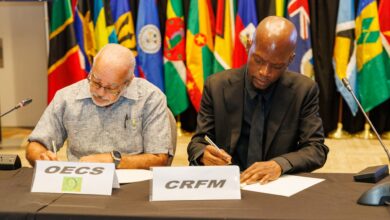(CARICOM Secretariat, Turkeyen, Greater Georgetown, Guyana) The palm tree which is so synonymous with the tourism industry in the Caribbean is under threat from a small red mite that has taken root and is severely affecting palm trees across the Caribbean Basin.
It was revealed by a scientist yesterday (15 July 2008) at a symposium on invasive species in Miami that the Red Palm Mite, which is believed to have first arrived in the Caribbean in 2003, could now be found in 12 Caribbean islands, Venezuela and two counties in the US State of Florida.
The tiny mite is a pest of coconut and ornamental palms, with the former being heavily used by the local population as an economic enterprise and the latter used to adorn many hotels and to a lesser extent, private homes in the Caribbean.
In a presentation at the US Department of Agriculture programme for Tropical and Subtropical Agriculture Research, T-STAR, sponsored symposium on invasive species, Red Palm Mite expert Dr Amy Roda revealed that coconut growers in the affected countries were reporting a 70 percent reduction in yield. In a study in which experts from the Caribbean and Florida, participated, it was further revealed that to date efforts at controlling this pest had not reaped significant results.
Dr Roda informed that the Red Palm Mite starts its attack on the small lower hung leaves on palm trees and once it has had its fill it moves to the more mature leaves causing a yellowing of the leaves of the affected trees.
She added that to date, officials in the affected countries have experimented with mainly two treatment methods, namely pesticides and natural enemies but neither had met with much success. She however stressed that efforts would continue on both fronts as a means of managing the pest.
The scientist was of the opinion that affected countries needed to combine their efforts and share expertise in dealing with Red Palm Mite. She revealed that with increase in tourist trade the Red Pal Mite is being unknowingly moved across national borders in souvenirs made out of palm, in particular green palm.
She informed that Florida had developed cooperation mechanism with cruise line officials and as a result cruise line passengers were “voluntarily declaring souvenirs made from palms when their boats dock at the port and before they actually leave the roads.”
The issue of the Red Palm Mite has started to attract increasing attention among plant specialists with an increasing number of studies taking place and with the formation of a Working Group on the pest with membership from the affected countries. The group will be meeting within the margins of the CFCS Meeting.
The increased attention stems from the reality that palms both coconut and ornamental do play an important role in the economies of Caribbean countries and therefore effort must be made to stem the tide of destruction.
The seriousness of the Red Palm Mite disease was also recognized by Caribbean Community (CARICOM) Plant Health officials at their inaugural meeting in Guyana in April this year. They concluded that coconuts were an important part of the economic life of the Caribbean as many countries had established industries based on the consumption of coconut water by nationals and tourists. They added that if the onset of invasive species such as the Red Palm Mite that affect palms were not dealt with on a continuous basis, the effect could be devastating.
Editor’s Note:
“Invasive species” means an alien species whose introduction does or is likely to cause economic environmental harm or harm to human health.
“Alien species” means, with respect to a particular ecosystem, any species, including its seeds, eggs, spores, or other biological material capable of propagating that species, that is not native to that ecosystem.





